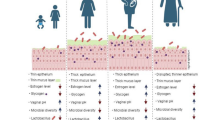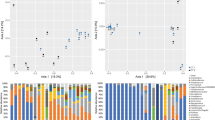Abstract
It has been long understood that the vaginal microflora is crucial in maintaining a normal physiological environment for the host and its involvement is deemed indispensable for reproductive success. A global concept of normalcy vs. dysbiosis of vaginal microbiome is debatable as women of different races have a unique vaginal microflora with regional variations. Vaginal microflora is a dynamic microenvironment affected by gestational status, menstrual cycle, sexual activity, age, and contraceptive use. Normal vaginal flora is dominated by lactobacilli especially in women of European descent vs. African American women. These microbes confer the host vagina protection from potentially pathogenic microbes that may lead to urinary tract infections and sexually transmitted diseases. Changes in the vaginal microbiota including reduced lactobacilli abundance and increased facultative and anaerobic organism populations result in bacterial vaginosis, that predisposes the host to several conditions like low birth weight and increased risk of contracting bacterial infections. On the other hand, the vaginal microbiome is also reshaped during pregnancy, with less microbial diversity with a dominance of Lactobacillus species. However, an altered vaginal microbiota with low lactobacilli abundance especially during pregnancy may result in induction of excessive inflammation and pre-term labor. Since the vaginal microbiome plays an important role during embryo implantation, it is not surprising that bacterial vaginosis is more common in infertile women and associated with reduced rates of conception. Probiotic has great success in treating bacterial vaginosis and restoring the normal microbiome in recent. This report, reviewed the relationships between the vaginal microbiome and women’s reproductive health.



Similar content being viewed by others
References
Aagaard K, Riehle K, Ma J, Segata N, Mistretta TA, Coarfa C et al (2012) A metagenomic approach to characterization of the vaginal microbiome signature in pregnancy. PLoS ONE 7(6):e36466
Anukam KC, Osazuwa EO, Ahonkhai I, Reid G (2006) Lactobacillus vaginal microbiota of women attending a reproductive health care service in Benin city Nigeria. Sex Transm Dis 33(1):59–62
Bahr PR (2007) Race and nutrition: an investigation of Black-White differences in health-related nutritional behaviours. Sociol Health Illn 29(6):831–856
Barbone F, Austin H, Louv WC, Alexander WJ (1990) A follow-up study of methods of contraception, sexual activity, and rates of trichomoniasis, candidiasis, and bacterial vaginosis. Am J Obstet Gynecol 163(2):510–514
Boris S, Barbés C (2000) Role played by lactobacilli in controlling the population of vaginal pathogens. Microbes Infect 2(5):543–546
Brotman RM, Shardell MD, Gajer P, Fadrosh D, Chang K, Silver MI et al (2014) Association between the vaginal microbiota, menopause status, and signs of vulvovaginal atrophy. Menopause 21(5):450–458
Casper RF (2009) Clinical manifestations and diagnosis of menopause. UpToDate, Waltham
Chaban B, Links MG, Jayaprakash TP, Wagner EC, Bourque DK, Lohn Z et al (2014) Characterization of the vaginal microbiota of healthy Canadian women through the menstrual cycle. Microbiome 2:23
Cribby S, Taylor M, Reid G (2008) Vaginal microbiota and the use of probiotics. Interdiscip Perspect Infect Dis. https://doi.org/10.1155/2008/256490
David LA, Maurice CF, Carmody RN, Gootenberg DB, Button JE, Wolfe BE et al (2014) Diet rapidly and reproducibly alters the human gut microbiome. Nature 505(7484):559–563
DiGiulio DB, Callahan BJ, McMurdie PJ, Costello EK, Lyell DJ, Robaczewska A et al (2015) Temporal and spatial variation of the human microbiota during pregnancy. Proc Natl Acad Sci USA 112(35):11060–11065
Dominguez-Bello MG, Costello EK, Contreras M, Magris M, Hidalgo G, Fierer N et al (2010) Delivery mode shapes the acquisition and structure of the initial microbiota across multiple body habitats in newborns. Proc Natl Acad Sci USA 107(26):11971–11975
Drell T, Lillsaar T, Tummeleht L, Simm J, Aaspõllu A, Väin E et al (2013) Characterization of the vaginal micro-and mycobiome in asymptomatic reproductive-age Estonian women. PLoS ONE 8(1):e54379
Eckburg PB, Bik EM, Bernstein CN, Purdom E, Dethlefsen L, Sargent M et al (2005) Diversity of the human intestinal microbial flora. Science 308(5728):1635–1638
Falagas ME, Betsi GI, Athanasiou S (2006) Probiotics for prevention of recurrent vulvovaginal candidiasis: a review. J Antimicrob Chemother 58(2):266–272
Farage MA, Miller KW, Sobel JD (2010) Dynamics of the vaginal ecosystem—hormonal Influences. Infect Dis: Res Treat. https://doi.org/10.4137/IDRT.S3903
Fettweis JM, Brooks JP, Serrano MG, Sheth NU, Girerd PH, Edwards DJ et al (2014) Differences in vaginal microbiome in African American women versus women of European ancestry. Microbiology 160(Pt 10):2272–2282
Gajer P, Brotman RM, Bai G, Sakamoto J, Schütte UM, Zhong X et al (2012) Temporal dynamics of the human vaginal microbiota. Sci Transl Med. https://doi.org/10.1126/scitranslmed.3003605
Georgijević A, Cjukić-Ivancević S, Bujko M (2000) Bacterial vaginosis. Epidemiology and risk factors. Srp Arh Celok Lek 128(1–2):29–33
Goldin BR, Adlercreutz H, Gorbach SL, Warram JH, Dwyer JT, Swenson L et al (1982) Estrogen excretion patterns and plasma levels in vegetarian and omnivorous women. N Engl J Med 307(25):1542–1547
Goldin BR, Woods MN, Spiegelman DL, Longcope C, Morrill-LaBrode A, Dwyer JT et al (1994) The effect of dietary fat and fiber on serum estrogen concentrations in premenopausal women under controlled dietary conditions. Cancer 74(3 Suppl):1125–1131
Guarner F, Schaafsma GJ (1998) Probiotics. Int J Food Microbiol 39(3):237–238
Harwich MD, Serrano MG, Fettweis JM, Alves JM, Reimers MA, Buck GA et al (2012) Genomic sequence analysis and characterization of sneathia amnii sp. nov. BMC Genomics. https://doi.org/10.1186/1471-2164-13-S8-S4
Hernández-Rodríguez C, Romero-González R, Albani-Campanario M, Figueroa-Damián R, Meraz-Cruz N, Hernández-Guerrero C (2011) Vaginal microbiota of healthy pregnant Mexican women is constituted by four Lactobacillus species and several vaginosis-associated bacteria. Infect Dis Obstet Gynecol. https://doi.org/10.1155/2011/851485
Hilakivi-Clarke L, Cho E, Cabanes A, DeAssis S, Olivo S, Helferich W et al (2002) Dietary modulation of pregnancy estrogen levels and breast cancer risk among female rat offspring. Clin Cancer Res 8(11):3601–3610
Hillier SL, Krohn MA, Nugent RP, Gibbs RS (1992) Characteristics of three vaginal flora patterns assessed by gram stain among pregnant women. Vaginal infections and prematurity study group. Am J Obstet Gynecol 166(3):938–944
Hillier SL, Krohn MA, Rabe LK, Klebanoff SJ, Eschenbach DA (1993) The normal vaginal flora, H2O2-producing lactobacilli, and bacterial vaginosis in pregnant women. Clin Infect Dis 16(Suppl 4):S273–S281
Hillier SL, Nugent RP, Eschenbach DA, Krohn MA, Gibbs RS, Martin DH et al (1995) Association between bacterial vaginosis and preterm delivery of a low-birth-weight infant. The vaginal infections and prematurity study group. N Engl J Med 333(26):1737–1742
Holzman C, Leventhal JM, Qiu H, Jones NM, Wang J, Group BS (2001) Factors linked to bacterial vaginosis in nonpregnant women. Am J Public Health 91(10):1664–1670
Hotel ACP, Cordoba A (2001) Health and nutritional properties of probiotics in food including powder milk with live lactic acid bacteria. Prevention 5(1):1–10
Huang Y, Merkatz RB, Hillier SL, Roberts K, Blithe DL, Sitruk-Ware R et al (2015) effects of a one year reusable contraceptive vaginal ring on vaginal microflora and the risk of vaginal infection: an open-label prospective evaluation. PLoS ONE 10(8):e0134460
Hummelen R, Macklaim JM, Bisanz JE, Hammond JA, McMillan A, Vongsa R et al (2011) Vaginal microbiome and epithelial gene array in post-menopausal women with moderate to severe dryness. PLoS ONE 6(11):e26602
Hyman RW, Fukushima M, Jiang H, Fung E, Rand L, Johnson B et al (2014) Diversity of the vaginal microbiome correlates with preterm birth. Reprod Sci 21(1):32–40
Jakobsson T, Forsum U (2007) Lactobacillus iners: a marker of changes in the vaginal flora? J Clin Microbiol 45(9):3145
Jespers V, Menten J, Smet H, Poradosú S, Abdellati S, Verhelst R et al (2012) Quantification of bacterial species of the vaginal microbiome in different groups of women, using nucleic acid amplification tests. BMC Microbiol 12:83
Karaoǧlu AŞ, Aydin F, Kiliç SS, Kilic A (2003) Antimicrobial activity and characteristics of bacteriocins produced by vaginal lactobacilli. Turk J Med Sci 33(1):7–13
Koumans EH, Sternberg M, Bruce C, McQuillan G, Kendrick J, Sutton M et al (2007) The prevalence of bacterial vaginosis in the United States, 2001–2004; associations with symptoms, sexual behaviors, and reproductive health. Sex Transm Dis 34(11):864–869
Lamont RF, Sobel JD, Akins RA, Hassan SS, Chaiworapongsa T, Kusanovic JP et al (2011) The vaginal microbiome: new information about genital tract flora using molecular based techniques. BJOG 118(5):533–549
Li K, Bihan M, Methé BA (2013) Analyses of the stability and core taxonomic memberships of the human microbiome. PLoS ONE 8(5):e63139
Ling Z, Kong J, Liu F, Zhu H, Chen X, Wang Y et al (2010) Molecular analysis of the diversity of vaginal microbiota associated with bacterial vaginosis. BMC Genomics 11:488
MacIntyre DA, Chandiramani M, Lee YS, Kindinger L, Smith A, Angelopoulos N et al (2015) The vaginal microbiome during pregnancy and the postpartum period in a European population. Sci Rep 5:8988
Mania-Pramanik J, Kerkar SC, Salvi VS (2009) Bacterial vaginosis: a cause of infertility? Int J STD AIDS 20(11):778–781
Martín V, Maldonado A, Fernández L, Rodríguez JM, Connor RI (2010) Inhibition of human immunodeficiency virus type 1 by lactic acid bacteria from human breastmilk. Breastfeed Med 5(4):153–158
Martínez-Peña MD, Castro-Escarpulli G, Aguilera-Arreola MG (2013) Lactobacillus species isolated from vaginal secretions of healthy and bacterial vaginosis-intermediate Mexican women: a prospective study. BMC Infect Dis 13:189
Miller EA, Beasley DE, Dunn RR, Archie EA (2016) Lactobacilli dominance and vaginal pH: why is the human vaginal microbiome unique? Front Microbiol 7:1936
Mirmonsef P, Hotton AL, Gilbert D, Burgad D, Landay A, Weber KM et al (2014) Free glycogen in vaginal fluids is associated with Lactobacillus colonization and low vaginal pH. PLoS ONE 9(7):e102467
Moi H (1990) Prevalence of bacterial vaginosis and its association with genital infections, inflammation, and contraceptive methods in women attending sexually transmitted disease and primary health clinics. Int J STD AIDS 1(2):86–94
Nasioudis D, Beghini J, Bongiovanni AM, Giraldo PC, Linhares IM, Witkin SS (2015) α-Amylase in vaginal fluid: association with conditions favorable to dominance of Lactobacillus. Reprod Sci 22(11):1393–1398
Neggers YH, Nansel TR, Andrews WW, Schwebke JR, Yu KF, Goldenberg RL et al (2007) Dietary intake of selected nutrients affects bacterial vaginosis in women. J Nutr 137(9):2128–2133
Ness RB, Hillier S, Richter HE, Soper DE, Stamm C, Bass DC et al (2003) Can known risk factors explain racial differences in the occurrence of bacterial vaginosis? J Natl Med Assoc 95(3):201–212
Oakley BB, Fiedler TL, Marrazzo JM, Fredricks DN (2008) Diversity of human vaginal bacterial communities and associations with clinically defined bacterial vaginosis. Appl Environ Microbiol 74(15):4898–4909
O’Hanlon DE, Moench TR, Cone RA (2013) Vaginal pH and microbicidal lactic acid when lactobacilli dominate the microbiota. PLoS ONE 8(11):e80074
Organization WHO (2012) Born too soon: the global action report on preterm birth. World Health Organization, Geneva. http://www.who.int/pmnch/media/news/2012/201204_borntoosoon-report.pdf
Panda S, Guarner F, Manichanh C (2014) Structure and functions of the gut microbiome. Endocr Metab Immune Disord Drug Targets 14(4):290–299
Pendharkar S, Magopane T, Larsson PG, de Bruyn G, Gray GE, Hammarström L et al (2013) Identification and characterisation of vaginal lactobacilli from South African women. BMC Infect Dis 13:43
Perry GH, Dominy NJ, Claw KG, Lee AS, Fiegler H, Redon R et al (2007) Diet and the evolution of human amylase gene copy number variation. Nat Genet 39(10):1256–1260
Petricevic L, Domig KJ, Nierscher FJ, Sandhofer MJ, Fidesser M, Krondorfer I et al (2014) Characterisation of the vaginal Lactobacillus microbiota associated with preterm delivery. Sci Rep 4:5136
Petrova MI, van den Broek M, Balzarini J, Vanderleyden J, Lebeer S (2013) Vaginal microbiota and its role in HIV transmission and infection. FEMS Microbiol Rev 37(5):762–792
Ravel J, Gajer P, Abdo Z, Schneider GM, Koenig SS, McCulle SL et al (2011) Vaginal microbiome of reproductive-age women. Proc Natl Acad Sci USA 108(Suppl 1):4680–4687
Reid G, Beuerman D, Heinemann C, Bruce AW (2001) Probiotic Lactobacillus dose required to restore and maintain a normal vaginal flora. FEMS Immunol Med Microbiol 32(1):37–41
Romero R, Hassan SS, Gajer P, Tarca AL, Fadrosh DW, Nikita L et al (2014a) The composition and stability of the vaginal microbiota of normal pregnant women is different from that of non-pregnant women. Microbiome 2(1):4
Romero R, Hassan SS, Gajer P, Tarca AL, Fadrosh DW, Bieda J et al (2014b) The vaginal microbiota of pregnant women who subsequently have spontaneous preterm labor and delivery and those with a normal delivery at term. Microbiome 2:18
Saunders S, Bocking A, Challis J, Reid G (2007) Effect of Lactobacillus challenge on gardnerella vaginalis biofilms. Colloids Surf B Biointerfaces 55(2):138–142
Sha BE, Chen HY, Wang QJ, Zariffard MR, Cohen MH, Spear GT (2005) Utility of Amsel criteria, Nugent score, and quantitative PCR for Gardnerella vaginalis, Mycoplasma hominis, and Lactobacillus spp. for diagnosis of bacterial vaginosis in human immunodeficiency virus-infected women. J Clin Microbiol 43(9):4607–4612
Sirota I, Zarek SM, Segars JH (2014) Potential influence of the microbiome on infertility and assisted reproductive technology. Semin Reprod Med 32(1):35–42
Smart S, Singal A, Mindel A (2004) Social and sexual risk factors for bacterial vaginosis. Sex Transm Infect 80(1):58–62
Sobel JD (1999) Is There a protective role for vaginal flora? Curr Infect Dis Rep 1(4):379–383
Spandorfer SD, Neuer A, Giraldo PC, Rosenwaks Z, Witkin SS (2001) Relationship of abnormal vaginal flora, proinflammatory cytokines and idiopathic infertility in women undergoing IVF. J Reprod Med 46(9):806–810
Spear GT, French AL, Gilbert D, Zariffard MR, Mirmonsef P, Sullivan TH et al (2014) Human α-amylase present in lower-genital-tract mucosal fluid processes glycogen to support vaginal colonization by Lactobacillus. J Infect Dis 210(7):1019–1028
Thoma ME, Klebanoff MA, Rovner AJ, Nansel TR, Neggers Y, Andrews WW et al (2011) Bacterial vaginosis is associated with variation in dietary indices. J Nutr 141(9):1698–1704
Tohill BC, Heilig CM, Klein RS, Rompalo A, Cu-Uvin S, Piwoz EG et al (2007) Nutritional biomarkers associated with gynecological conditions among US women with or at risk of HIV infection. Am J Clin Nutr 85(5):1327–1334
Ursell LK, Metcalf JL, Parfrey LW, Knight R (2012) Defining the human microbiome. Nutr Rev 70(Suppl 1):S38-44
van de Wijgert JH, Borgdorff H, Verhelst R, Crucitti T, Francis S, Verstraelen H et al (2014) The vaginal microbiota: what have we learned after a decade of molecular characterization? PLoS ONE 9(8):e105998
van Oostrum N, De Sutter P, Meys J, Verstraelen H (2013) Risks associated with bacterial vaginosis in infertility patients: a systematic review and meta-analysis. Hum Reprod 28(7):1809–1815
Vandenbergh PA (1993) Lactic acid bacteria, their metabolic products and interference with microbial growth. FEMS Microbiol Rev 12(1–3):221–237
Verstraelen H, Verhelst R, Claeys G, De Backer E, Temmerman M, Vaneechoutte M (2009) Longitudinal analysis of the vaginal microflora in pregnancy suggests that L. crispatus promotes the stability of the normal vaginal microflora and that L. gasseri and/or L. iners are more conducive to the occurrence of abnormal vaginal microflora. BMC Microbiol. https://doi.org/10.1186/1471-2180-9-116
Willson RJ, Goforth ML (1942) Effect of an excess of ingested carbohydrate upon the glycogen content of vaginal epithelium. J Clin Endocrinol Metab 2(4):223–225
Wright VC, Chang J, Jeng G, Macaluso M, (CDC) CfDCaP (2008) Assisted reproductive technology surveillance–United States 2005. MMWR Surveill Summ 57(5):1–23
Xiao BB, Liao QP (2012) Analysis of diversity of vaginal microbiota in healthy Chinese women by using DNA-fingerprinting. Beijing Da Xue Xue Bao Yi Xue Ban 44(2):281–287
Zhou X, Brown CJ, Abdo Z, Davis CC, Hansmann MA, Joyce P et al (2007) Differences in the composition of vaginal microbial communities found in healthy Caucasian and black women. ISME J 1(2):121–133
Żukiewicz-Sobczak W, Wróblewska P, Adamczuk P, Silny W (2014) Probiotic lactic acid bacteria and their potential in the prevention and treatment of allergic diseases. Cent Eur J Immunol 39(1):104–108
Author information
Authors and Affiliations
Contributions
SAS and VSS performed the literature review and compiled the initial draft. Both authors contributed equally. HB and PMG contributed to critical review, editing, and approved the final draft. SJ and AA contributed to writing, editing, and prepared the graphic art.
Corresponding authors
Additional information
Communicated by Erko Stackebrandt.
Publisher's Note
Springer Nature remains neutral with regard to jurisdictional claims in published maps and institutional affiliations.
Viqar Sayeed Saraf and Sohail Aslam Sheikh contributed equally.
Rights and permissions
About this article
Cite this article
Saraf, V.S., Sheikh, S.A., Ahmad, A. et al. Vaginal microbiome: normalcy vs dysbiosis. Arch Microbiol 203, 3793–3802 (2021). https://doi.org/10.1007/s00203-021-02414-3
Received:
Revised:
Accepted:
Published:
Issue Date:
DOI: https://doi.org/10.1007/s00203-021-02414-3



